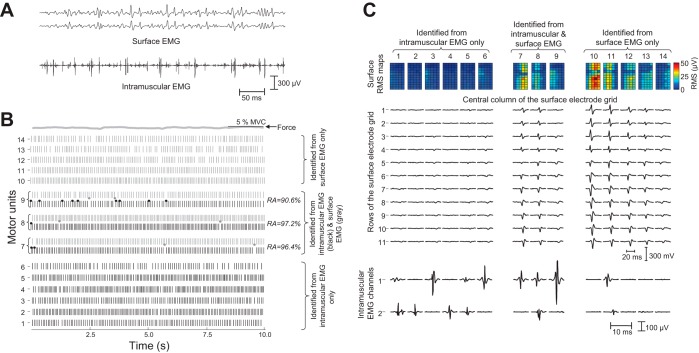Fig. 8.
Comparison of motor unit discharge times as identified by decomposing surface and intramuscular EMG recordings. A: surface (11 × 5 electrode grid) and intramuscular (2 Teflon-coated electrode wires) EMG systems were used to record the activity of motor units in the biceps brachii muscle during a contraction at 5% MVC force. Two surface EMG and 1 intramuscular EMG signals are shown. B: surface and the intramuscular signals were independently decomposed using the CKC algorithm (51) (grey spike trains) and the EMG Lab method (76) (black spike trains), respectively. Some of the decomposed motor units were observed in both the surface and the intramuscular EMG signals, so that a direct comparison of the 2 algorithms was possible. In this example, 6 motor units (1–6) were identified from the intramuscular EMG signals only, 5 from the surface EMG system only (10–14), and 3 by both systems (7–9). In B, middle, the grey circles represent action potentials detected from the surface EMG signal but not from the intramuscular EMG signal, whereas black circles are those action potentials identified in the intramuscular signal only. The rate of agreement (RA) between the 2 decomposition methods for the 3 common motor units ranged from ∼90 to ∼97% of the total number of detected action potentials. C: maps of the surface EMG amplitude as detected by the 11 × 5 surface electrode grid for each identified motor unit (1–14) obtained by spike-triggered averaging. The 11 traces in C, middle, indicate the spike-triggered averages recorded from the middle column and the 11 rows of the surface electrode grid. The amplitudes of the spike-triggered averages were greatest for those motor units that were discriminated from the surface EMG signals and least for those identified in the intramuscular signals only. In contrast, the bottom 2 rows indicate that the spike-triggered averages derived from the intramuscular action potentials for each motor unit (1–14) were greatest for those motor units discriminated in the intramuscular signals and least for those identified in the surface EMG signals only. RMS, root mean square. [© 2010 IEEE. Reprinted, with permission, from Holobar et al. (53).]

